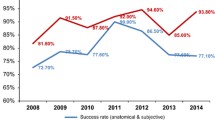Abstract
Maxillectomy followed by radiotherapy and/or chemotherapy can result in lacrimal blockage and the need for subsequent dacryocystorhinostomy (DCR). Endonasal endoscopic DCR, as opposed to external DCR, allows better accuracy and leaves no scar. To date no report was published regarding the results of endoscopic DCR in these patients. The current study presents a retrospective review of all patients with paranasal and skull base tumors who developed nasolacrimal duct blockage after ablative maxillectomy with or without radiotherapy and/or chemotherapy and underwent endonasal endoscopic DCR between January 2006 and October 2012 in a tertiary reference medical center. According to our results, ten patients underwent 11 subsequent endonasal endoscopic DCR. There were 6 men and 4 women with a median age of 55 years (range, 19–81 years); four suffered from benign tumors and six had malignant tumors. All underwent maxillectomy. Six received high-dose radiotherapy. Time interval between primary ablative surgery and endonasal endoscopic DCR was 18 months (range, 7–118 months). Silicone stents were removed after median period of 11 weeks (range, 1–57 weeks). Nine out of ten patients experienced symptomatic improvement following one endonasal endoscopic DCR. One patient had recurrent epiphora and underwent a successful endonasal endoscopic revision DCR. In conclusion, endonasal endoscopic DCR in patients with paranasal and skull base tumors, who previously underwent maxillectomy, is generally successful and not associated with a high rate of complications or failure. Moreover, our findings may suggest that silicone stents can be removed shortly after the operation with high success rate.
Similar content being viewed by others
References
Osguthorpe JD, Calcaterra TC (1979) Nasolacrimal obstruction after maxillary sinus and rhinoplastic surgery. Arch Otolaryngol Head Neck Surg 105:264–266
Smith B, Lisman RD, Baker D (1984) Eyelid and orbital treatment following radical maxillectomy. Ophthalmology 91:218–228
Glatt HJ, Chan AC (1991) Lacrimal obstruction after medial maxillectomy. Ophthal Sur 22:757–758
Habib R, Har-El G (2004) Management of the lacrimal system during maxillectomy. Am J Rhinol 18:367–370
Osguthorpe JD, Weisman RA (1991) “Medial maxillectomy” for lateral nasal wall neoplasms. Arch Otolaryngol Head Neck Surg 117:751–756
Yeo N-K, Wang JH, Chung Y-S, Jang YJ, Lee B-J (2010) Contributing factors to prevent prolonged epiphora after maxillectomy. Arch Otolaryngol Head Neck Surg 136:229–233
Gordon KB, Char DH, Sagerman RH (1995) Late effects of radiation on the eye and ocular adnexa. Int J Radiat Oncol Biol Phys 31:1123–1139
Nakissa N, Rubin P, Strohl R, Keys H (1983) Ocular and orbital complications following radiation therapy of paranasal sinus malignancies and review of literature. Cancer 51:980–986
Parsons JT, Bova FJ, Fitzgerald CR, Mendenhall WM, Million RR (1994) Severe dry-eye syndrome following external beam irradiation. Int J Radiat 30:775–780
Caravella LP, Burns JA, Zangmeister M (1981) Punctal-canalicular stenosis related to systemic fluorouracil therapy. Arch Ophthalmol 99:284–286
Fezza JP, Wesley RE, Klippenstein KA (1999) The treatment of punctal and canalicular stenosis in patients on systemic 5-FU. Ophthal Surg Lasers 30:105–108
Esmaeli B, Valero V, Ahmadi MA, Booser D (2001) Canalicular stenosis secondary to docetaxel (taxotere): a newly recognized side effect. Ophthalmology 108:994–995
Esmaeli B (2002) Docetaxel secretion in tears association with lacrimal drainage obstruction. Arch Ophthalmol 120:1180
Esmaeli B, Hidaji L, Adinin RB (2003) Blockage of the lacrimal drainage apparatus as a side effect of docetaxel therapy. Cancer 98:504–507
Ahmadi MAEB (2001) Surgical treatment of canalicular stenosis in patients receiving docetaxel weekly. Arch Ophthalmol 119:1802–1804
Fliss DM, Abergel A, Cavel O, Margalit N, Gil Z (2007) Combined subcranial approaches for excision of complex anterior skull base tumors. Arch Otolaryngol Head Neck Surg 133:888–896
Ben Simon GJ, Joseph J, Lee S, Schwarcz RM, McCann JD, Goldberg R (2005) External versus endoscopic dacryocystorhinostomy for acquired nasolacrimal duct obstruction in a tertiary referral center. Ophthalmology 112:1463–1468
Karim R, Ghabrial R, Lynch T, Tang B (2011) A comparison of external and endoscopic endonasal dacryocystorhinostomy for acquired nasolacrimal duct obstruction. Clin Ophthalmol 5:979–989
Sprekelsen MB, Barberán MT (1996) Endoscopic dacryocystorhinostomy: surgical technique and results. Laryngoscope 106:187–189
Diba R, Saadati H, Esmaeli B (2005) Outcomes of dacryocystorhinostomy in patients with head and neck tumors. Head Neck 27:72–75
El-Sawy T, Ali R, Nasser QJ, Esmaeli B (2012) Outcomes of dacryocystorhinostomy in patients with head and neck cancer treated with high-dose radiation therapy. Ophthal Plast Reconstr Surg 28:196–198
Andersen PE, Kraus DH, Arbit E, Shah JP (1996) Management of the orbit during anterior fossa craniofacial resection. Arch Otolaryngol Head Neck Surg 122:1305–1307
Sessions RB, Humphreys DH (1983) Technical modifications of the medial maxillectomy. Arch Otolaryngol 109:575–577
Imola MJ, Schramm VL (2002) Orbital preservation in surgical management of sinonasal malignancy. Laryngoscope 112:1357–1365
Caversaccio M, Hausler R (2006) Insertion of double bicanalicular silicone tubes after endonasal dacryocystorhinostomy in lacrimal canalicular stenosis: a 10-year experience. ORL J Otorhinolaryngol Relat Spec 68:266–269
Chong KK, Lai FH, Ho M (2013) Randomized trial on silicone intubation in endoscopic mechanical dacryocystorhinostomy (SEND) for primary nasolacrimal duct obstruction. Ophthalmology (Epub ahead of print)
Al-Qahtani AS (2012) Primary endoscopic dacryocystorhinostomy with or without silicone tubing: a prospective randomized study. Am J Rhinol Allergy 26:332–334
Acknowledgments
Dr. Orit Gutfeld, for helping with collecting data regarding the radiation therapy. Esther Eshkol, the institutional medical and scientific copyeditor, for editorial assistance.
Conflict of interest
None reported.
Author information
Authors and Affiliations
Corresponding author
Rights and permissions
About this article
Cite this article
Abu-Ghanem, S., Ben-Cnaan, R., Leibovitch, I. et al. Outcomes of endonasal endoscopic dacryocystorhinostomy after maxillectomy in patients with paranasal sinus and skull base tumors. Eur Arch Otorhinolaryngol 271, 1513–1518 (2014). https://doi.org/10.1007/s00405-013-2706-7
Received:
Accepted:
Published:
Issue Date:
DOI: https://doi.org/10.1007/s00405-013-2706-7




